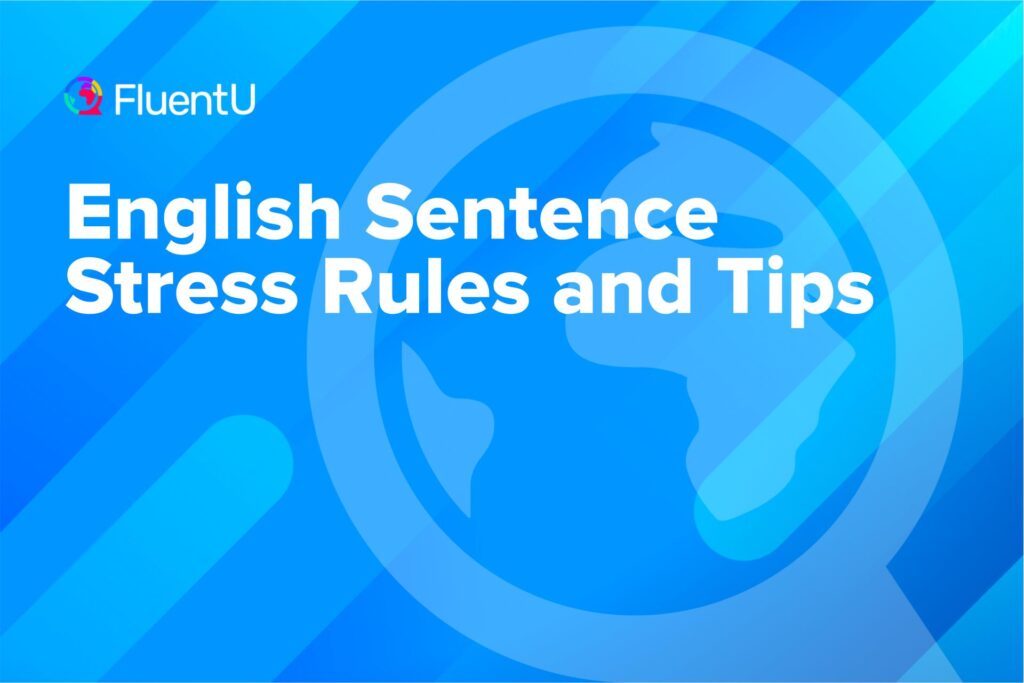English Sentence Stress Rules and Tips

Every language has stress rules. When you learn a new language, you use the stress and music from your native language without meaning to. But when you do this, your English might sound off.
By improving your sentence stress in English, you’ll be improving your speaking and listening skills, as well.
Download: This blog post is available as a convenient and portable PDF that you can take anywhere. Click here to get a copy. (Download)
What is Sentence Stress in English?
So you know that sentence stress is the music of the language, but what does that mean exactly? English is a stress-timed language that has a pattern of stressed and unstressed syllables and words. You change stress to emphasize, give new information, contrast information or to clarify.
In other words, English lets you put the stress on different words (or parts of words) to change the meaning of the whole sentence. You can make some information more important than the rest of the sentence through sentence stress.
In English, we have content words and structure words. You can think about it in terms of “strong” and “soft” beats.
Content words
Content words are the “strong” beats and usually include words with more lexical (more in-depth) meaning, such as nouns ( cat , house ), verbs ( sleep , run ), adverbs ( slowly , quickly ) and adjectives ( small , large ). The main stress in these words gets the emphasis, or stress, in a sentence:
I’m sorry. The class is full. (I’m SORry. The CLASS is FULL.)
Lions and tigers and bears, oh my. (LIons and TIgers and BEARS, oh MY.)
Try saying the sentences above out loud, putting a stronger stress on the capitalized parts. You can even drum the beat on a table, hitting harder as you say the stressed words.
In this video, Tom Hanks, an American movie actor, performs slam poetry about the classic television series “Full House.” You can really hear the emphasis on the content words.
There are other words that can be content words, depending on the meaning. These include the following: Wh-words ( who , what , where and why ), interjections ( yes , ahh , dear me ) and negatives ( can’t , won’t ). For example:
No, you can’t come. (NO, you CAN’T come.)
What are you saying? (WHAT are you SAYing?)
Structure words
Structure words are the “soft” beats with less meaning in the sentence. They provide the grammatical elements of the sentence and are said with a quieter beat. Structure words are articles ( a , an ), prepositions ( in , on ), conjunctions ( but , and ), pronouns ( I , you ) and auxiliary verbs ( is , was ).
For example, the words “I,” “the” and “is” in the following example are structure words:
I know. The store is full. (I KNOW. The STORE is FULL.)
If you give a strong beat to the wrong word or even the wrong syllable, you can change the meaning or make the sentence hard to understand. “You enjoy HIStory,” can sound like “You enjoy his STOry.”
Here’s a video from Rachel’s English going over content and structure word stress in action.
Focus Words in Sentence Stress
You now know about the strong and soft beats that make up the music of the English language. In every sentence or phrase, there’s one word that has the main emphasis or focus. The loudest part is the strong syllable of the focus word.
Focus words help your listener understand the main point of what you’re trying to convey. It can provide essential or new information. It can contrast ideas or even make a correction.
Many times, the focus word is the last content word in the phrase or sentence:
Taylor Swift is amazing! (Taylor Swift is AMAzing!)
Sometimes, though, you might move the focus word to change the meaning of your sentence. For example, if someone asks you what you plan to do next year, you might answer:
I’m going to college. (I’m going to COLlege.)
The focus is the answer to the question: College is where you’ll be going.
On the other hand, if someone misheard that your sister is going to college, you might respond:
I’M going to college.
In this case, the focus is on the fact that it’s you (and not your sister) who’s going to college.
Pitch changes in focus words
Along with placing a stronger stress on the focus word, you’ll also need to raise the pitch—that is, make the sound of your voice higher.
To understand this better, St. George International has a great video that shows how stress and pitch placed on different words in the same sentence can completely change the meaning of the sentence.
Understanding the pitch change can also help improve your listening comprehension skills. When you hear the pitch change, you know what’s coming is critical. For those taking the TOEFL or IELTS listening test, practicing listening for the pitch change can improve your score.
Jill Diamond offers up some quick tips on how to identify the focus words in her online videos.
If you want more help on the topic, English with Lucy is super popular for a reason: She has lots of useful videos on English pronunciation.
Thought Groups
If you’re going to practice sentence stress, you have to also understand thought groups. Thought groups are phrases or sentences that express your “thought” by using natural pausing and a focus word.
In writing, we use punctuation (periods, commas, question marks) to show the natural pause.
Roses are red, violets are blue. (The comma shows the natural pause.)
In speech, you do this by adding a slight or quick pause before going to the next thought group. If you don’t pause, the sentences stream together, making your ideas unclear or completely wrong.
Let’s eat Grandma! (Let’s eat GRANDma!)
Let’s eat, Grandma! (Let’s EAT, GRANDma!)
In the first example above, you’re telling the listener you want to eat Grandma. And in the second, you’re telling Grandma that it’s time to eat. Both mean very different things, shown through a correctly emphasized and paused thought group.
Not only do you pause at the end of a thought group, but you also use pitch and intonation—or the rise and fall of our voice—to signal the pause.
I love eating Grandpa. I love eating, Grandpa.
(I love eating ↗GRANDpa. I love ↗EATing,↘ ↗GRANDdpa!)
You can hear this in action with this silly animation from Justin Franco.
You can also have more than one thought group within a sentence. And within each thought group, you have a focus word:
It’s better to be safe than sorry. (It’s better to be SAFE than SORry.)
Where there’s a will, there’s a way. (Where there’s a WILL, there’s a WAY.)
You can think of it like you’re “chunking” the language. Pronunciation Pro has some “chunking videos” that break down intonation and pausing.
Gabby Wallace from Go Natural English has some dynamic English pronunciation videos on thought groups that help you chunk like a native speaker.
Sources to Master Sentence Stress
Learning about sentence stress isn’t enough! These resources help you hear and practice the music of the language:
- “Well Said”: If you want to buy a pronunciation textbook, it should be the “Well Said” series by Linda Grant and Eve Einselen Yu. The books have fun activities that focus on all the important features of English pronunciation, including sentence stress.
The series goes over the latest research in pronunciation in addition to TOEFL iBT preparation exercises. You can access the audio for the textbook online.
- FluentU: This website and app lets you learn with short English videos featuring native speakers.
FluentU takes authentic videos—like music videos, movie trailers, news and inspiring talks—and turns them into personalized language learning lessons.
You can try FluentU for free for 2 weeks. Check out the website or download the iOS app or Android app.
P.S. Click here to take advantage of our current sale! (Expires at the end of this month.)

- English Club: This is a free website for English learners that covers the rhythm of sentence stress. You can listen and practice with included bite-sized chunks of dialogue or learn about sentence stress rules. English Club is an excellent place to start when first learning about the beat of sentence stress.
- Oxford Online English: If you love YouTube, then you’re going to love Oxford Online English. You can subscribe to their channel and watch and learn from pronunciation experts all about English sentence stress.
You’ll never become bored with a vast (large) selection of pronunciation videos, taught by certified teachers.
Sentence stress is all about hearing the beat and using the English rhythm correctly. It’s not about having a perfect accent, but rather about emphasizing the correct focus word by raising and lowering your pitch, and taking a pause when needed.
Mastering sentence stress is a small step you can take that’ll help you sound much more natural when speaking English!
Download: This blog post is available as a convenient and portable PDF that you can take anywhere. Click here to get a copy. (Download)
And One More Thing...
If you like learning English through movies and online media, you should also check out FluentU. FluentU lets you learn English from popular talk shows, catchy music videos and funny commercials, as you can see here:
The FluentU app and website makes it really easy to watch English videos. There are captions that are interactive. That means you can tap on any word to see an image, definition, and useful examples.
For example, when you tap on the word "searching," you see this:
Learn all the vocabulary in any video with quizzes. Swipe left or right to see more examples for the word you’re learning.

FluentU helps you learn fast with useful questions and multiple examples. Learn more.
The best part? FluentU remembers the vocabulary that you’re learning. It gives you extra practice with difficult words—and reminds you when it’s time to review what you’ve learned. You have a truly personalized experience.
Start using the FluentU website on your computer or tablet or, better yet, download the FluentU app from the iTunes or Google Play store. Click here to take advantage of our current sale! (Expires at the end of this month.)











